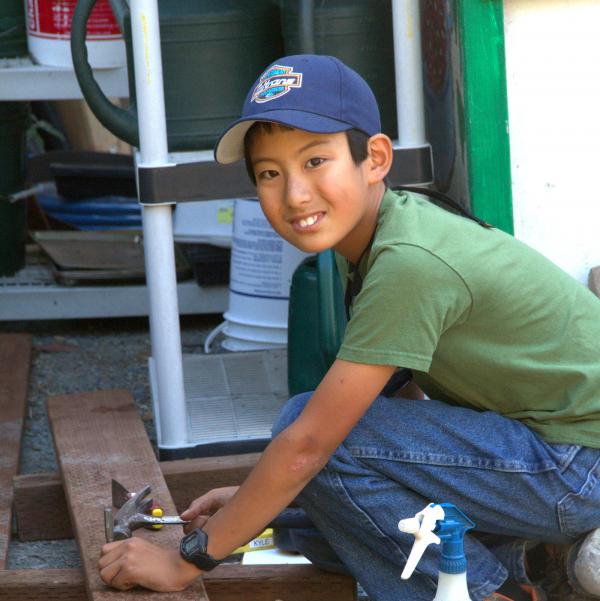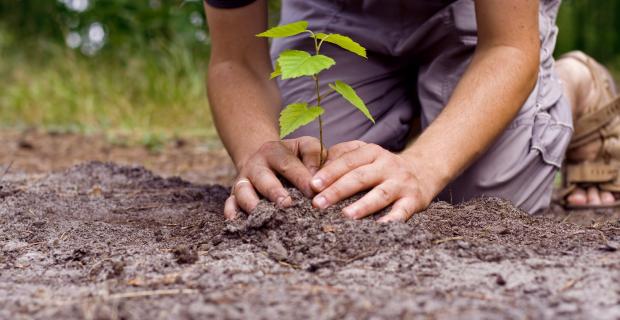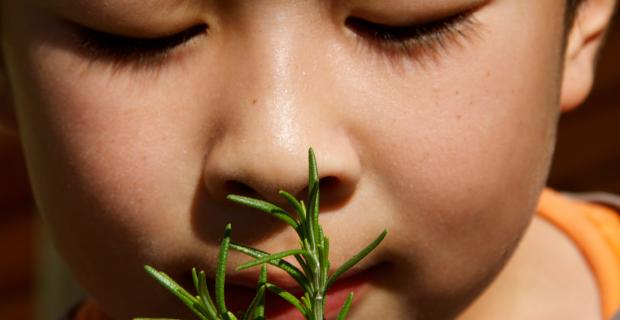Against All Odds, School Gardens Thrive in West Contra Costa

By Alice Lee Tebo
At Madera Elementary in El Cerrito, California, "lunchtime" has new meaning. When the noon bell rings, it's time to eat — but it's also time to work, play, and dream in the school's one-acre garden. Students cuddle with chickens, play house under the avocado tree, discover slugs in the lettuce, and "give compost gifts" to hungry soil. Anything goes, as long as it's done with care and respect.
On a fall day that feels like mid-summer, Madera garden coordinator Molly Wahl presides over this lush patch of earth humming with happy activity. "We're like a secret garden tucked away," she says, "and then there's the synergy of adding children to this landscape." Third- to sixth-grade classes hop through the gate, check out the "to do" list of options scrawled on the shed's whiteboard, and grab their gardening tools of choice. Some mix compost into raised beds, now emptied of summer crops; others hunker down to weed, water, and sweep. Many go on "chicken patrol" while peppering a patient Wahl with questions about their four feathered friends.
Even the shed is a lively, colorful place, with an attractive array of well-worn gardening gloves suspended from clothespins and supplies freshly organized by two sixth-grade boys. One of its walls, painted one weekend by a team of parents and students, depicts plants paired with a finished dish — carrot with tzimmes, spinach with palak paneer, cucumber with kappa sushi....
It's hard to imagine that seven years ago, "There was nothing here but rubble from the school expansion," Wahl recalls. A terraced hillside bursts with sunflowers, lavender, artichokes, plums, clementines, corn, gourds, and more. Natives, elderberries, and alpine strawberries flourish on a neighboring hillside, along with kitchen herbs, lemon trees, and a "wildlife habitat" buzzing with birds and bees. Quail, hummingbirds, newts, and deer are among many faithful visitors. It won't be long before kale, chard, and other fall-winter edibles take root in 12 raised beds and 20 wine half-barrels; once harvested, they will be sold in the school's popular Farmers Market, run by third-graders on Fridays from January to June.
Over the past five years, veteran teacher Wahl has transformed the Madera garden into a fertile outdoor classroom fully integrated into daily life. But it takes a village. "I have 100-percent buy-in here," she says. "I'm working with every class from kindergarten to sixth grade. Our principal is totally on board, and the teachers are really seeing the benefits. Everything taught in the classroom can be taught here." In addition to lunchtime, the garden hosts regular instructional time throughout the academic year, in after-school enrichment classes, and during a summer schedule made possible by staff, family, and community volunteers.
Wahl works constantly to keep things interesting, offering yoga in the garden, a mobile cooking cart, and a "Garden Girls" group for fourth- to sixth-graders who "need a little work on resilience, self-esteem, and communication." In creating curriculum for Garden Girls as well as all other classes, Wahl turned to the Center for Ecoliteracy's latest book, Ecoliterate: How Educators Are Cultivating Emotional, Social, and Ecological Intelligence. "I've tied the five Ecoliterate practices into everything we're doing this year," she says. The kindergarten unit, "Roots and Shoots: Using Our Senses to Study Plants," for example, is designed to help students develop empathy for all forms of life and make the invisible visible. Another unit addressing all five practices turns sixth-graders into apprentice landscapers. "They restore and plant natives and create habitats for bees and butterflies," Wahl explains. "They produce scaled site plans and present them to a panel of judges. The winning plan gets a budget, and then the students make it happen. It's a very real, practical learning experience. That's the direction STEM curriculum wants us to go."
Wahl stresses that gardens are the ideal place for children to develop emotional and social intelligence. "I say that day in and day out. Students will get into heated arguments at recess, but then they'll come to me and ask if they can go into the garden and talk. Parents will actually bring in kids who have ongoing problems with each other and have them work it out in the garden. You get rid of artifice and fear and speak from the heart here. To me, gardens are much more holistic in what they offer."
Thanks to a recent Center for Ecoliteracy grant, Wahl is one step closer to fulfilling her dream of two separate spaces — a "learning garden" dedicated to cross-curricular, hands-on activities and a "market garden" focused on crops for the Farmers Market. "We were able to hire a landscaper to design a really beautiful site plan for the market garden," she says. "It's something that we can take to the district to show our vision."
The grant is one of many given by the Center for Ecoliteracy to gardens throughout West Contra Costa Unified School District (WCCUSD), which serves more than 30,000 students pre-K to 12th grade. Eighty-six percent are students of color, with one in three receiving services for English-language learners; more than two-thirds of all students are eligible for free or reduced-price lunches. Gangs, drugs, and violence rock cities like Richmond, where poverty rates are double the national average. "Many neighborhoods in WCCUSD are urban food deserts," says Carolie Sly, the Center for Ecoliteracy's education program director. "And yet the school garden community and culture is thriving. Richmond in particular is a Transition Town, and the mayor is really behind improving community resilience, so we felt they were ripe for change."
This growing movement is nurtured by a grassroots collaborative of teachers, administrators, community members, and students. Recently renamed West County DIGS (Developing Instructional Gardens in the Schools), they came together in 2007 with one mission: to make their school garden programs more successful and sustainable through the power of community. Today, the district boasts over 30 working gardens — and counting. DIGS conducted a district-wide survey for the first time last year and identified major needs (e.g. paid staffing) and benefits (e.g. increased curiosity); the results enabled them to successfully lobby for the inclusion of school gardens in WCCUSD's five-year strategic plan.
In addition to funding release time for DIGS members to develop lessons, the Center for Ecoliteracy grants are helping their garden programs realize their potentials. Mira Vista Elementary in Richmond purchased apple trees to plant a small orchard; a donated apple press will further engage students. Making Waves Academy and El Cerrito High are revitalizing their gardens with needed improvements and supplies. Hercules High School is expanding its garden so that a biology teacher can use it to teach about life systems and the chef can incorporate fresh food in school meals. And Richmond High's Urban Agriculture Institute is upgrading its greenhouse and starting an aquaponics system.
The Institute at Richmond High is one of several bright spots in Richmond run by DIGS partner Urban Tilth. The local agriculture and food justice nonprofit also oversees the Verde Elementary School Partnership Garden, which serves as an outdoor laboratory for classroom learning and an affordable, healthy food source for the underserved community, many of whom are immigrants who personally tend their crops. Washington Elementary's Edible Education Garden Program includes cooking and nutrition education, teacher training, and resiliency small groups.
"DIGS isn't daunted by the challenges of working with kids from unstable households and dangerous neighborhoods," notes Sly. "They're just completely dedicated to bringing fresh food and healthy relationships to these schools." As part of the Center for Ecoliteracy's ongoing support of the collaborative, Sly meets with members every six weeks to facilitate resource sharing, community outreach, and making the connection to academic standards. "We see our role as helping them build their own capacity. They started this a long time ago without us. We're there to help them keep the momentum going." Adds Wahl, "The Center for Ecoliteracy is providing wisdom. All of us have our feet on the ground, but they're coming in from another place, and that helps us see from a new perspective."
The ambitions of DIGS are evolving. "We have these brilliant individuals doing really cool things," Wahl notes. "They're all over, but they're secrets! We're trying to reveal what's happening and create linkages. It's just not sustainable to do solo work. We succeed through sharing and community, not reinventing the wheel." While increased visibility and promotion are priorities, building strength from within is paramount. "Many of our goals have relied on the district," she says. "We want to have the table set so they can join us, but we have to use our own expertise in the here and now to bring us all up together. One of the things that I think is really special about DIGS is that it is so grassroots — everyday folks coming together in their off-work hours to do something they believe in. These gardens are happening around the edges and in the margins. They are happening in spite of and against all odds. Nature sets the bar high, and everyone rises to it."




